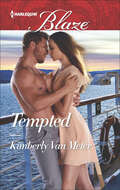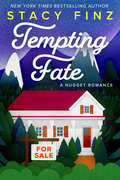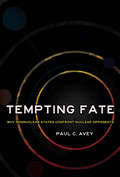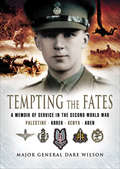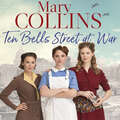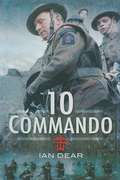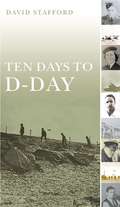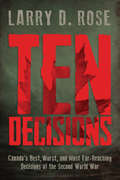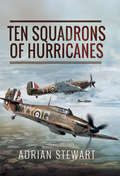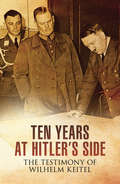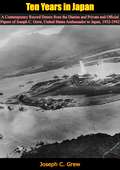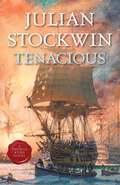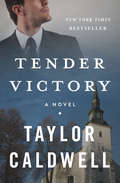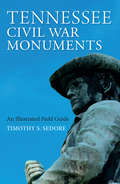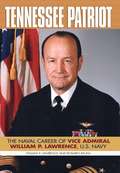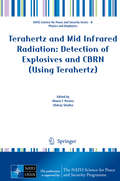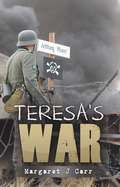- Table View
- List View
Tempt the Night
by Dixie Lee BrownDixie Lee Brown concludes her thrilling Trust No One series with the fast-paced tale of a damaged hero and the sexy fugitive he can't help falling for.Samantha "Mac" McCallister barely believes her own tale of dirty cops and murder that landed her in the hands of the sexy Jim Brady. One minute she was enjoying a ride-along in her best friend's cruiser, the next he's dead and she's wanted for his murder. Mac never expected to be hiding out from the law, but with Jim by her side, maybe she can survive long enough to clear her name. The question is, can she survive the way Jim makes her feel?Former Navy Seal Jim Brady works best under pressure. At least he used to. Now, fighting flashbacks from his time in Iraq, he has given up everything he knows in order to protect the innocent ... from himself. So working with a woman on the run from the law? Not in his plans for this lifetime. Still, something about the blue-eyed beauty tells him she's not the source of the danger--she's running from it. Deep down he knows he'll protect her no matter what. But his heart? That's another story.
Tempted by the Soldier
by Patricia PotterForgetting the past, facing the future Stephanie Phillips is sick of charm. And Clint Morgan, the newest resident of Covenant Falls, has it in spades. Stephanie knows she should run the other way because the former Blackhawk pilot is too good-looking, too charismatic...and much too sexy. As the town veterinarian, Stephanie has truly found her home here. Clint, on the other hand, is staying for only a short time while he recovers from an injury. But when he starts to fit seamlessly into the close-knit community, the irresistible risk-taker makes his way into her heart.
Tempted: Sizzling Summer Nights Tempted A Cowboy In Paradise Her Holiday Fling
by Kimberly Van Meter Kimberly Van MeterOne woman’s plans for her singles cruise getaway change when she lays eyes on the sexy Air Force veteran in the cabin next door in this steamy romance.Her greatest temptation . . . As far as Harper Riley is concerned, attraction can’t be trusted. Money, on the other hand, lasts forever. Which is why Harper’s on a singles cruise for her latest: a wealthy widower who might just need a new wife. So why can’t she keep her eyes—or her dirty thoughts—off the ruggedly hot guy in the room next to hers?Of course, the charming ones are always broke, and Teagan Carmichael is both ridiculously charming and inexcusably broke. Worse still, there’s some serious heat sizzling between them. But Harper has too much riding on this trip to have her head turned by Mr. Deliciously-Sexy-But-Poor. She already knows that giving in to a little temptation can turn into a whole lot of trouble . . .
Tempting Fate (A Nugget Romance #10)
by Stacy FinzFrom the bestselling author of Falling Hard, a woman determined to put smalltown life behind her has second thoughts when a hunky stranger moves in.Raylene Rosser is Nugget&’s most infamous prodigal daughter. The townspeople aren&’t exactly holding a welcome home parade when she returns, but that&’s okay with Raylene—she&’s only here to make amends for selfish mistakes, sell her property, and get out of town asap after her half-brother Logan&’s wedding. Picturesque Nugget is her past, and Raylene is determined to build a future . . .All of which would be easier if Logan hadn&’t asked his business partner to keep an eye on her. A security specialist, Gabe Moretti certainly knows how to shadow a girl—and how to boss said girl around. It would be infuriating, if only Raylene could keep her eyes off Gabe&’s broad chest, rugged profile, and sexy smile. Falling in love might not be the safe choice, but sometimes everyone needs to tempt fate . . .This ebook contains a bonus Q&A with the author!Praise for the writing of Stacy Finz&“Sweet humor, well-defined and appealing characters, and just enough adventure sports and fashion detail make Finz&’s print debut, and series launch, a delightful read.&” —Library Journal on Need You
Tempting Fate: Why Nonnuclear States Confront Nuclear Opponents (Cornell Studies in Security Affairs)
by Paul C. AveyWhy would countries without nuclear weapons even think about fighting nuclear-armed opponents? A simple answer is that no one believes nuclear weapons will be used. But that answer fails to consider why nonnuclear state leaders would believe that in the first place. In this superb unpacking of the dynamics of conflict under conditions of nuclear monopoly, Paul C. Avey argues that the costs and benefits of using nuclear weapons create openings that weak nonnuclear actors can exploit.Tempting Fate uses four case studies to show the key strategies available to nonnuclear states: Iraqi decision-making under Saddam Hussein in confrontations with the United States; Egyptian leaders' thinking about the Israeli nuclear arsenal during wars in 1969–70 and 1973; Chinese confrontations with the United States in 1950, 1954, and 1958; and a dispute that never escalated to war, the Soviet-United States tensions between 1946 and 1948 that culminated in the Berlin Blockade. Those strategies include limiting the scope of the conflict, holding chemical and biological weapons in reserve, seeking outside support, and leveraging international non-use norms. Counterintuitively, conventionally weak nonnuclear states are better positioned to pursue these strategies than strong ones, so that wars are unlikely when the nonnuclear state is powerful relative to its nuclear opponent. Avey demonstrates clearly that nuclear weapons cast a definite but limited shadow, and while the world continues to face various nuclear challenges, understanding conflict in nuclear monopoly will remain a pressing concern for analysts and policymakers.Thanks to generous funding from Virginia Tech and its participation in TOME (Toward an Open Monograph Ecosystem), the ebook editions of this book are available as Open Access (OA) volumes, available from Cornell Open (cornellopen.org) and other Open Access repositories.
Tempting the Fates: A Memoir of Service in the Second World War
by Major General Dare WilsonGeneral Dare Wilson saw action in France 1940 (Dunkirk), Italy and North West Europe (where he won his MC) with the Northumberland Fusiliers and later the Recce Regiment. He then served in Palestine and Korea which he rates as the most vicious war he fought in. He was picked to command 22 SAS and was responsible for basing them at Hereford. His account of the world record-breaking free fall jump free falling from 34,000 feet makes thrilling reading one member died. He went on to fight the Mau Mau in Kenya and was in the last party to leave Aden when we withdrew in 1968. Dare then learnt to fly helicopters and commanded the fledgling Army/Air Corps. We believe that this is one of the most enthralling of the many superb memoirs we have published. Certainly it is the widest in its scope and makes for thrilling reading.
Ten Bells Street (The Spitalfields Sagas #1)
by Mary CollinsThe East End of London, 1930. Work is scarce, food is in short supply and there is political unrest on the streets. But in the face of all this hardship, there's always friendship.Becky, Bernie and Rose - three best friends from very different backgrounds - are working hard to establish themselves in pre-war Spitalfields. Becky, the daughter of a Jewish tailor, wants to become a nurse, but her father has more traditional plans for her. Aching to leave the East End and travel the world, Bernie feels trapped by her vast family of poor Irish dock workers. And then there is Rose. Tiny and thin, she lives with her drunken mother and a revolving selection of surrogate fathers who exploit and brutalise them both.But at least the girls have each other and, as Europe begins to drift towards another war, their friendships become ever more crucial as each one of them fights for their place in an ever-changing, frightening, new world. One way or another, love will pull them through . . .
Ten Bells Street (The Spitalfields Sagas #1)
by Mary CollinsThe East End of London, 1930. Work is scarce, food is in short supply and there is political unrest on the streets. But in the face of all this hardship, there's always friendship.Becky, Bernie and Rose - three best friends from very different backgrounds - are working hard to establish themselves in pre-war Spitalfields. Becky, the daughter of a Jewish tailor, wants to become a nurse, but her father has more traditional plans for her. Aching to leave the East End and travel the world, Bernie feels trapped by her vast family of poor Irish dock workers. And then there is Rose. Tiny and thin, she lives with her drunken mother and a revolving selection of surrogate fathers who exploit and brutalise them both.But at least the girls have each other and, as Europe begins to drift towards another war, their friendships become ever more crucial as each one of them fights for their place in an ever-changing, frightening, new world. One way or another, love will pull them through . . .
Ten Bells Street at War (The Spitalfields Sagas #2)
by Mary CollinsCan their friendship survive the struggles of war?1940, the East End of London.Life is tough for the Ten Bells Street girls. Best friends from childhood, the three of them now find themselves scattered across London, surviving the war apart. Exiled from the East End, Rose has created a new life for herself and now works as a dancer in a club in Soho - but life in the West End has its problems too. With the arrival of the war, Becky has finally found work as a nurse, but as the bombs continue to fall she struggles to cope with the damage that surrounds her. And Bernie may have achieved her lifelong dream of becoming a professional photographer, but she's never felt more distanced from her family and her life in the East End.Separated by circumstances, the girls' friendship stands strong in the face of hardship as they fight for their place in a frightening new world. One way or another, love will pull them through...
Ten Bells Street at War (The Spitalfields Sagas #2)
by Mary CollinsCan their friendship survive the struggles of war?1940, the East End of London.Life is tough for the Ten Bells Street girls. Best friends from childhood, the three of them now find themselves scattered across London, surviving the war apart. Exiled from the East End, Rose has created a new life for herself and now works as a dancer in a club in Soho - but life in the West End has its problems too. With the arrival of the war, Becky has finally found work as a nurse, but as the bombs continue to fall she struggles to cope with the damage that surrounds her. And Bernie may have achieved her lifelong dream of becoming a professional photographer, but she's never felt more distanced from her family and her life in the East End.Separated by circumstances, the girls' friendship stands strong in the face of hardship as they fight for their place in a frightening new world. One way or another, love will pull them through...
Ten Commando
by Ian DearIt is indeed remarkable, since the archives of the Second World War must have been pillaged, ransacked, burrowed into, and turned over almost as thoroughly as Monte Cassino itself, that no book has been written about one of the strangest units created during that or any other conflict. The unit was called Ten Commando - and the shroud of secrecy that enveloped it at the time has scarcely been un-wrapped by the passge of the years. Ten Commando was composed entirely of men who came from Germany and from Nazi-occupied countries such as Holland, Poland, and France. Secrecy was vital, for if an Axis agent infiltrated into Ten Commando he could do untold harm. If a member of Ten Commando were capture and his unit identified, the rules of the Geneva Convention were unlikely to worry the captors. This overwhelming need for absolute secrecy was so well instilled in the men of Ten Commando that, until now, little was known about their daring exploits behind enemy lines, including coordination of resistance fighters and sabotage. The result of Ian Dears painstaking research is a remarkable book indeed and a worthy tribute to an incredibly brave group of cladestine soldiers who belong near the top of the WWII Roll of Honor.
Ten Days that Shook the World
by John Reed"This book is a slice of intensified history—history as I saw it.” So begins John Reed’s first-hand account of the Bolshevik Revolution of 1917. Much anticipated when it was published in 1919, Reed’s narrative remains as riveting today as when the events he describes were still reverberating throughout the world. Reed was hardly a disinterested observer, and his involvement in the Communist labor movement lends urgency and passion to his classic account. He vividly describes events in Petrograd in November 1917, when Vladimir Lenin and the Bolsheviks stormed the Winter Palace and seized the reins of power. Despite Reed’s personal leanings, which he made no attempt to hide, the book garnered praise from luminaries across the political spectrum. George F. Kennan, the American diplomat, and father of the policy of Soviet containment, said that “Reed’s account of the events of that time rises above every other contemporary record for its literary power, its penetration, its command of detail. It will be remembered when all others are forgotten."Reed was committed to telling the story of the Russian revolution as truthfully as possible. That the book was banned by Russian premier Josef Stalin is a testament to the author’s success in carrying out his mission. One hundred years after Russia and the world trembled, Ten Days that Shook the World brings alive the momentous events of 1917.
Ten Days to D-Day: Citizens and Soldiers on the Eve of the Invasion
by David StaffordTen days before the largest operation of World War II was launched, it was still one of the century's best-kept secrets--thanks to countless ordinary people participating in one of history's most remarkable moments. David Stafford has written a riveting account of ten of those ordinary men and women--including an American paratrooper, a German soldier, a nineteen-year-old English woman working on secret codes, a Parisian Jew in hiding, and a daring French resistance cell--as they lived through ten very extraordinary days. Drawing on previously unpublished diaries and letters, Stafford gives readers a fresh point of entry into one of the most significant battles ever fought.Ten Days to D-Day buzzes with the pace of a novel, as Stafford moves from country to country, from character to character, including some of D-Day's leaders: Hitler, Rommel, Eisenhower, and Churchill. Stafford compellingly brings to life the final days before the invasion through the eyes of its participants, the citizens and soldiers that made history on June 6, 1944.
Ten Decisions: Canada’s Best, Worst, and Most Far-Reaching Decisions of the Second World War
by Larry D. RoseIn the chaos of the Second World War, Canada faced cruel choices, both on the battlefield and in the world of politics. Of all these life-and-death choices, ten stand above the others in their importance, their agonizing stakes, and the impact they have on the country to this day.
Ten Squadrons of Hurricanes
by Adrian StewartFor many years the importance and contribution of the Hawker Hurricane was eclipsed by the Spitfire but statistically the Hurricane was superior in the majority of cases. Thanks to Tommy Sopwiths initiative and gamble the Hurricane was ready at the outbreak of the Second World War and in service throughout.As this superbly researched book reveals by examining the roles, actions and personalities of ten Hurricane squadrons, this iconic aircraft was not only exceptionally robust but astonishingly versatile. We track its performance from the Battle of France and Britain through the Middle East, Italy and on to Burma. It excelled as day and night interceptor, intruder and importantly as a rocket firing tank buster.The Hurricane inspired great loyalty among its pilots and their colourful personalities and thrilling experiences make this splendid book an informative and entertaining read.
Ten Years at Hitler's Side: The Testimony of Wilhelm Keitel
by Bob CarruthersIn October 1946, Wilhelm Keitel was executed by hanging after being sentenced to death at the Nuremburg Trials. His road to this point was a long and controversial one, from the heady days of the surrender of France, to the eventual fall of Berlin and his subsequent arrest. There were few men better positioned to provide insight in to the minds and workings of the National Socialist Party, and of those a preciously limited amount were held accountable for their crimes. This renders the record of Keitels trial as published here an invaluable historical record that goes some way to providing an understanding of the near incomprehensible crimes committed during the Third Reich.Edited and introduced by esteemed historian Bob Carruthers, this unadulterated record of Wilhelm Keitels trial at Nuremburg is essential reading for all history enthusiasts and an important account of events that truly shook the world.
Ten Years in Japan: A Contemporary Record Drawn from the Diaries and Private and Official Papers of Joseph C. Grew, United States Ambassador to Japan, 1932-1942 (World Affairs Ser.)
by Joseph C. GrewAmerica’s Ambassador to Tokyo for the ten years before Pearl Harbor tells the full story of how and why America went to war with Japan. He draws that story from three first-hand sources: his own day-to-day diaries, his personal and official correspondence, and his dispatches to the State Department. From this huge mass of material, he has woven together a chronological narrative of history in the making.President Hoover sent Ambassador Grew to Japan in 1932 because he needed the best diplomat we had to save a desperate situation. The Japanese militarists had already seized Manchuria. They had assassinated half a dozen outstanding moderate statesmen. They were preparing to quit the League, scrap Washington Treaties, and dominate Asia and the Far Pacific.Ambassador Grew’s mission had two purposes. One was to uphold American rights in the Far East. The other was to avoid war. The attitude of the Japanese made it impossible for the U.S. to pursue both these policies indefinitely, but Ambassador Grew’s diplomacy postponed the showdown, preserved the peace, and upheld America’s national honor.Ten Year in Japan tells for the first time the full, inside story of the decade of conflict, intrigue, and surprise that culminated in the inevitable tragedy of war.
Ten-Thirty-Three: The Inside Story of Britain's Secret Killing Machine in Northern Ireland
by Nicholas DaviesThis explosive book reveals the conspiracy between British Military Intelligence and the gunman of the UDA who targeted and killed both Republican terrorists and ordinary Catholics. The secret partnership was sanctioned at the highest level of the British government and full details of planned operations, including killings, were passed directly to its Joint Intelligence Committee in London. Ten-Thirty-Three was the codename given to the agent who was fed with all the details necessary for Loyalist gunmen to carry out their murderous activities. But somewhere along the line the power went to Ten-Thirty-Three’s head and he became increasingly unpredictable. It wasn’t long before he was completely out of control, and his Military Intelligence bosses had the makings of a major catastrophe on their hands… This extraordinary true story lifts the lid on shocking abuses of power in Belfast in the 1980s and 1990s.
Tenacious
by Julian StockwinThomas Paine Kydd is in Halifax enjoying the recognition and favour of his fellow officers when Tenacious is summoned to join Horatio Nelson's task force on an urgent reconnaissance mission. Intelligence suggests the French Revolution is about to set the Mediterranean ablaze, but Bonaparte's fleet is nowhere to be found. Nelson and his band of brothers begin a desperate search for him. Kydd's newfound ambition fuels his desire to be at the forefront of the hunt. But with power comes responsibility; with responsibility, accountability. Kydd will face his greatest challenge ever amidst bloodstained seas. And defeat will mean humiliation—or death.
Tender Victory: A Novel
by Taylor CaldwellNew York Times Bestseller: The &“touching and effective&” story of an American minister who returns home from WWII with five orphaned Holocaust survivors (The New York Times). Rev. Johnny Fletcher serves wounded soldiers from the battlefield as a military chaplain during World War II. His forté is spiritual solace in the darkest of times, but his life changes when he performs a public heroic act: facing down an angry mob intent on attacking five young Holocaust survivors. Upon learning they have no homes or families to return to, Fletcher decides to bring them to America. To his dismay, his coal-mining community of Barryfield, Pennsylvania, greets this makeshift family with prejudice and distrust. Beneath the town&’s placid surface run buried religious divisions. Fletcher&’s commitment to raising the children according to their individual faiths—two Protestant, two Catholic, and one Jewish—meets with horrific levels of intolerance. Dealing with such prejudice turns more sinister still when a local newspaper publisher cynically uses the story for his own purposes. Together with Lorry Summerfield, the beautiful, disillusioned daughter of Barryfield&’s most powerful figure, Fletcher must try to awaken the townspeople to the better angels of their nature before it&’s too late.
Tennessee Civil War Monuments: An Illustrated Field Guide
by Timothy S. Sedore“A superb guide to 400 statues, columns, reliefs, and other components of the state’s commemorative landscape.” —Gary W. Gallagher, author of The Union WarThroughout Tennessee, Civil War monuments stand tall across the landscape, from Chattanooga to Memphis, and recall important events and figures within the Volunteer State’s military history. In Tennessee Civil War Monuments, Timothy S. Sedore reveals the state’s history-laden landscape through the lens of its many lasting monuments. War monuments have been cropping up since the beginning of the commemoration movement in 1863, and Tennessee is now home to four hundred memorials. Not only does Sedore provide commentary for every monument—its history and aesthetic panache—he also explores the relationships that Tennessee natives have with these historic landmarks.A detailed exploration of the monuments that enrich this Civil War landscape, Sedore’s Tennessee Civil War Monuments is a guide to Tennessee’s spirit and heritage.
Tennessee Civil War Monuments: An Illustrated Field Guide
by Timothy S. Sedore“A superb guide to 400 statues, columns, reliefs, and other components of the state’s commemorative landscape.” —Gary W. Gallagher, author of The Union WarThroughout Tennessee, Civil War monuments stand tall across the landscape, from Chattanooga to Memphis, and recall important events and figures within the Volunteer State’s military history. In Tennessee Civil War Monuments, Timothy S. Sedore reveals the state’s history-laden landscape through the lens of its many lasting monuments. War monuments have been cropping up since the beginning of the commemoration movement in 1863, and Tennessee is now home to four hundred memorials. Not only does Sedore provide commentary for every monument—its history and aesthetic panache—he also explores the relationships that Tennessee natives have with these historic landmarks.A detailed exploration of the monuments that enrich this Civil War landscape, Sedore’s Tennessee Civil War Monuments is a guide to Tennessee’s spirit and heritage.
Tennessee Patriot
by Rosario Rausa William P. LawrenceBill Lawrence served his country for thirty-seven years in a remarkable naval career filled with triumphs and adversities. A naval aviator and test pilot who commanded a fighter squadron in the Vietnam War, he was shot down in combat and held by the North Vietnamese at the notorious Hanoi Hilton prison for six years. During his imprisonment he became a hero among heroes, demonstrating superior qualities of leadership, physical strength, and mental acumen, tap-coding messages to keep his sanity while withstanding solitary confinement and regular torture sessions. Upon release from captivity, Lawrence learned that his wife and the mother of their children had divorced him and remarried. Although these events had a severe emotional impact on him, he resumed his distinguished naval career, rising swiftly through the ranks, remarrying, and being named to such prestigious positions as Commander of the Third Fleet, Superintendent of the Naval Academy, and Chief of Naval Personnel. In this autobiography, Lawrence credits much of his resolve and ability to overcome difficulties to his strong and nurturing parents, his youth in Nashville, Tennessee, his experiences at the U.S. Naval Academy (where he served as brigade commander and earned letters in three varsity sports), and to the love and support of his wife Diane. With the help of his friend and writer Zip Rausa, the admiral tells his story without glossing over the darker elements. This recounting of his path on an extraordinary journey through life is uniquely American and filled with lessons for us all.
Terahertz and Mid Infrared Radiation: Detection of Explosives and CBRN (Using Terahertz)
by Oleksiy Shulika Mauro F. PereiraThe reader will find here a timely update on new THz sources and detection schemes as well as concrete applications to the detection of Explosives and CBRN. Included is a method to identify hidden RDX-based explosives (pure and plastic ones) in the frequency domain study by Fourier Transformation, which has been complemented by the demonstration of improvement of the quality of the images captured commercially available THz passive cameras. The presented examples show large potential for the detection of small hidden objects at long distances (6-10 m). Complementing the results in the short-wavelength range, laser spectroscopy with a mid-infrared, room temperature, continuous wave, DFB laser diode and high performance DFB QCL have been demonstrated to offer excellent enabling sensor technologies for environmental monitoring, medical diagnostics, industrial and security applications. From the new source point of view a number of systems have been presented - From superconductors to semiconductors, e. g. Detection of Terahertz Waves from Superconducting Bi2Sr2CaCu2O8+δ Intrinsic Josephson Junctions The quest for a compact room temperature THz source and the recent advances in high power mid-IR QCLs lead to the development of a semiconductor THz source based on intracavity difference frequency generation. Furthermore, alternative electrically pumped THz sources based on the high emission efficiency predicted for polaritonic states in the ultra-strong coupling regime led to the demonstration of electroluminescent devices. Finally, antipolaritons in dispersive media were discussed and different aspects of the interaction of THz radiation with biomatter were presented.
Teresa's War
by Margaret J Carr<p>The story is based on a scrap of information the author was recent told. The extraordinary story is a previous unrecorded, and unconfirmed, story of bravery during WW2.</p><p>It’s 1942. A small peasant farm, in the mountainous region of Nazi occupied Austria. On it lived a man, his wife and two daughters seven and five years old. Their life was relatively unaffected by the war, even if a Nazi garrison was close to the tiny village in the Tyrol. That was until the night a terrified family of Hungarian Jews, desperate to escape across the border, hid in a barn on the property and suddenly the family was in great danger. It was Teresa, their seven year old, who led the refugees to safety under the very noses of the Germans.</p>


